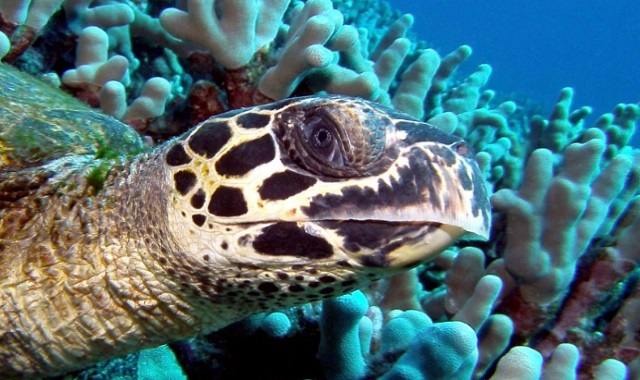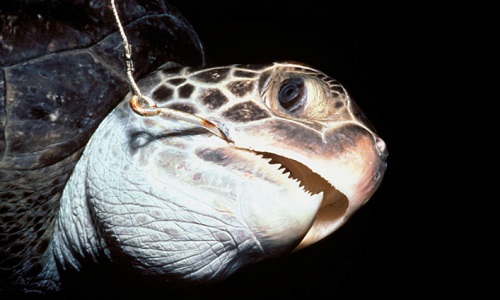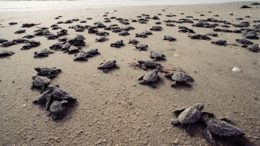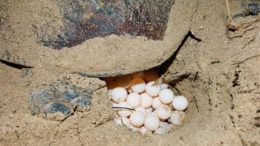
A Hawksbill Sea Turtle in Key West Aquarium.
Interesting Facts
- The Hawsksbill Sea Turtle is the most endangered of all the turtle species. Its population has declined over 80% in a century.
- One of the most important reasons for the global decline of the Hawksbill Sea Turtle has been the high demand for its richly patterned shell. It is used in a variety of products including tortoise shell combs, inlays in fine furniture and jewelry. Its bones were used to make tools and other parts to make traditional medicine. Its decline is also due to its use as ceremonial and religious practice.
- A shell can sell for up to $100 a pound (450 grams).
- One Hawksbill can consume 1,000 lbs of sponges per year, if they are not eaten by Hawksbills coral reefs can suffocate.
- More than 50% of turtles eggs are stolen by humans.
- Eating sea turtles and their eggs can cause chelonotoxism.
Name
- Scientific Name: Eretmochelys imbricata.
- Common Name: Hawksbill Turtle, Hawksbill Sea Turtle.
Conservation Status and Action
- The Hawksbill Sea Turtle is considered a Critically Endangered Species by the International Union for the Conservation of Nature (IUCN).
- This species is protected by Appendix I of The Convention for International Trade in Endangered Species of Fauna and Flora (CITES) outlawing its capture and the trade of products derived from them.
- They are listed as endangered under the Endangered Species Act.
- The Hawksbill is listed in Appendices I and II of the Convention on Migratory Species (CMS)
- Many countries have outlawed the exploitation of sea turtles and their eggs through regional legislation and enforcement.
Distribution and Population
- Hawksbill Sea Turtles have a global distribution throughout the tropics and subtropical waters of the Atlantic, Indian and Pacific Oceans.
- They nest in at least 70 countries and are believed to inhabit the coastal waters of at least 108 countries.
- This species has seen a population decline of over 80% over the last century.
- There are two subpopulations: Atlantic (Eretmochelys imbricata imbricata) and Indo-Pacific (Eretmochelys imbricata bissa).
- The largest populations are found in the coasts of the Caribbean Sea, Mexico, Indonesia, Seychelles and Australia.
- Major threats to its population is the result of over exploitation of adult females and their eggs, degradation of nesting and marine habitats, slaughter for meat, accidental death due to marine fisheries, pollution, juvenile and adult catches for tortoiseshell trade.

Hawksbill Sea Turtle distribution. Map adapted from IUCN Red List of Threatened Species.
Habitat
- Hawksbills nest on tropical and subtropical sandy beaches.
- They are migratory species and use a number of habitats throughout their lives.
- Juveniles inhabit foraging environments not far from the beaches where they were born.
- When their carapace reach 20 to 30 cm they inhabit coral reefs, algal beds, creeks or mud flats. As they get older they tend to live in deeper sites.
- When they reach sexual maturity at 20 to 25 years they start migrating from foraging grounds to breeding areas.
Physical Description
- This species of sea turtle grows on average to 3 feet (1 meter) in length and weight an average of 180 lb (80 kg). They are medium size compared to other sea turtles.
- Like other sea turtles Hawksbills have a flattened body shape with a protective carapace and flippers to swim.
- They have five distinctive features that differentiate them from other sea turtles:
- Two pairs of prefrontal scales on their heads.
- Their long heads end in a beak which is sharp and curved with a serrated appearance, its hook beak resembles that of a hawk, therefore their name.
- Their carapace have five ventral scutes, that resemble large scales, and four costal scutes running along each side.
- Two claws on each of their forelimbs.
- Colorful and bright carapace.
- The color of its carapace ranges from gold amber to dark brown with mottled brown-grey colors and red, black and orange streaks.
- Hawksbill hatchlings making their journey to water
- A hawksbill laying eggs on a sandy beach
Behavior
- Like other sea turtles Hawksbills are solitary animals, they meet only to mate.
- They migrate when they reach sexual maturity believed to be at age 20 to 25 years, depending on the region.
- Sea turtles cannot withdraw their heads into their shell for protection.
- They spend most of their lives submerged in water but they need to breathe oxygen every 5 minutes during activity.
- They sleep underwater.
Reproduction
- Hawksbill Sea Turtles breed in shallow waters every two to three years. The Atlantic population mate from April to November while the Indian Ocean population from September to February.
- The nesting process lasts from one to three hours. Females clear the area and dig a hole in the sandy beach with their rear flippers, lay their eggs and cover them with sand. After the process is finished they return to the sea.
- They nest about 4 times per season every two weeks and lay on average 140 eggs per nest.
- After two months the eggs hatch. The baby turtles weight about 0.85 oz (24 gr) and measure less than one inch long (2.5 cm). They crawl into the sea, if they do not make it by daylight they are likely to be preyed by birds or other predators.
Diet
- Hawksbill Sea Turtles are omnivorous. They consume mainly sponges found on coral reefs but they also eat crustaceans, jellyfish, fish and algae.
Life Expectancy
- Unknown
Taxonomy

Hawksbill turtle caught in a long line.
- Kingdom: Animalia
- Phylum: Chordata
- Class: Mammalia
- Order: Testudines
- Family: Cheloniidae
- Genus: Eretmochelys
- Species: Eretmochelys imbricata
References and further research
- International Union for the Conservation of Nature (IUCN) eretmochelys imbricata
- Convention on International Trade of Endangered Species of Flora and Fauna
- Convention on Conservation of Migratory Species of Wild Animals
- National Oceanic and Atmospheric Administration
- US Fish and Wildlife Service Hawksbill Sea Turtle (eretmochelys imbricata)
- Government of Australia Department of the Environment and Energy Hawksbill Turtle (eretmochelys imbricata)
- University of Michigan Museum of Zoology eretmochelys imbricata Hawksbill
- Sea Turtle Conservancy


